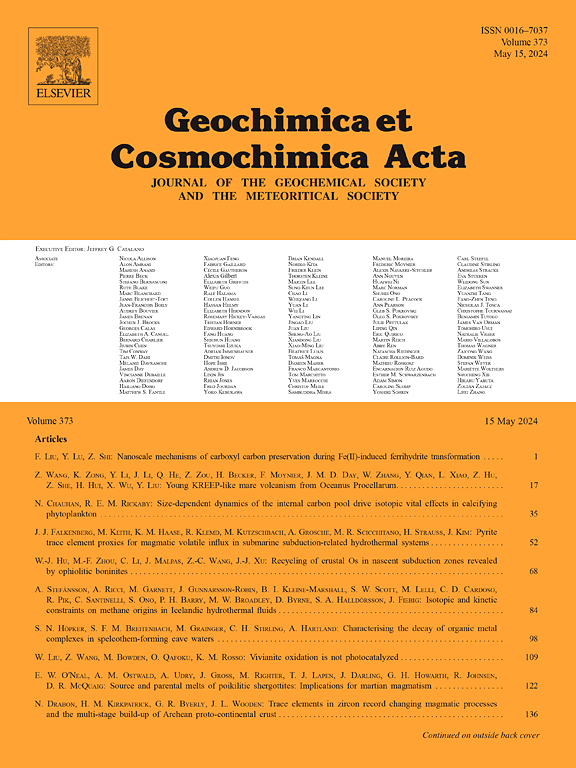Revisiting magnesium isotope constraints on the petrogenesis of the Fe-Ti oxide-bearing mafic–ultramafic intrusions
IF 4.5
1区 地球科学
Q1 GEOCHEMISTRY & GEOPHYSICS
引用次数: 0
Abstract
Stable isotopes of metals, such as magnesium (Mg) and iron (Fe), typically undergo minimal fractionation at magmatic temperatures. However, in Fe-Ti oxide-bearing intrusions, significant Mg isotope fractionation (Δ26Mg values of up to 23 ‰) has been observed between silicates and Fe-Ti oxides. The mechanism responsible for this substantial fractionation remains unclear. This study presents Mg isotopic compositions for bulk rocks and mineral separates—including olivine, clinopyroxene, titanomagnetite, ilmenite—from sixteen Fe-Ti oxide ores in both the lower and the upper zones of the Baima layered mafic–ultramafic intrusion, as well as bulk rocks from three high-Ti basalts of the Emeishan large igneous province, SW China. Oxide ores from the lower zone and the lower section of the upper zone of the Baima intrusion are characterized by a low abundance of volatile-bearing minerals, such as apatite and hornblende. These ores exhibit δ26Mg values ranging from −0.30 to −0.14 ‰ for olivine, −0.26 to −0.06 ‰ for clinopyroxene, 0.16 to 0.60 ‰ for titanomagnetite and −0.33 to −0.21 ‰ for ilmenite, indicative of near-equilibrium fractionation. In contrast, oxide ores from the upper section of the upper zone exhibit a high abundance of volatile-bearing minerals and significantly different δ26Mg values, ranging from −0.19 to −0.05 ‰ for olivine, −0.25 to −0.10 ‰ for clinopyroxene, 0.57 to 0.60 ‰ for titanomagnetite and 0.86 to 2.34 ‰ for ilmenite, indicative of disequilibrium fractionation. A negative correlation between Fo content and δ26Mg value in olivine suggests that Mg isotopes fractionate as olivine undergoes fractional crystallization. Trapped liquid fractions, calculated based on Ce contents in apatite, suggest that rocks with high volatile-bearing mineral content have undergone re-equilibration with trapped liquids during cooling. The large disequilibrium Mg isotopic fractionation between silicates and Fe-Ti oxides is likely due to sub-solidus re-equilibration between minerals and trapped liquids. We propose that the extent of sub-solidus, diffusion-driven kinetic Mg isotopic fractionation in Fe-Ti oxide-bearing intrusions likely correlates with the volume of trapped liquids, which may serve as a significant medium accelerating ion exchange between silicates and Fe-Ti oxides. Moreover, mass balance calculations indicate that data of Mg isotopes on their own are insufficient to determine the petrogenesis of Fe-Ti oxides in layered intrusions. This insufficiency is primarily due to the low MgO content in titanomagnetite and ilmenite, where their separation causes minimal Mg isotopic fractionation of the melts.
求助全文
约1分钟内获得全文
求助全文
来源期刊

Geochimica et Cosmochimica Acta
地学-地球化学与地球物理
CiteScore
9.60
自引率
14.00%
发文量
437
审稿时长
6 months
期刊介绍:
Geochimica et Cosmochimica Acta publishes research papers in a wide range of subjects in terrestrial geochemistry, meteoritics, and planetary geochemistry. The scope of the journal includes:
1). Physical chemistry of gases, aqueous solutions, glasses, and crystalline solids
2). Igneous and metamorphic petrology
3). Chemical processes in the atmosphere, hydrosphere, biosphere, and lithosphere of the Earth
4). Organic geochemistry
5). Isotope geochemistry
6). Meteoritics and meteorite impacts
7). Lunar science; and
8). Planetary geochemistry.
 求助内容:
求助内容: 应助结果提醒方式:
应助结果提醒方式:


